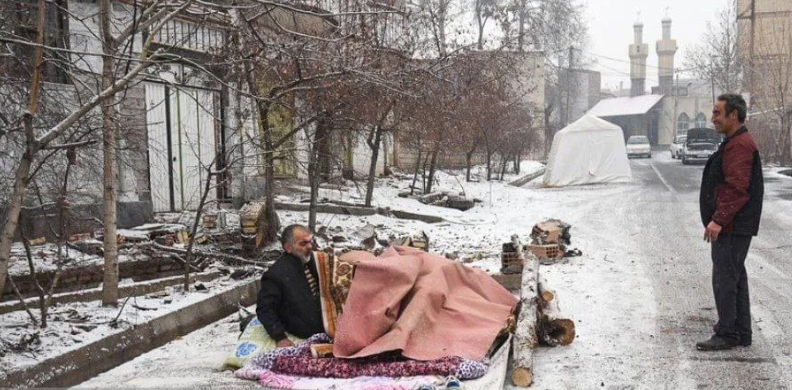February 17, 2023

Three people were killed and more than 1,000 injured as a 5.9 earthquake rattled the Kurdish region the night of Saturday, January 28 and it has become a major political issue as the public has complained about the slowness and limited relief and rescue effort provided by the regime.
The quake was centered near the city of Khoy in West Azerbaijan province.
About 70 villages around Khoy were also damaged by the quake.
Khoy residents started protesting the next day over what they felt was a lack of relief aid from the government.
Videos posted on social media showed security forces using water cannon to disperse demonstrators gathered in front of the regional administrative building in Khoy. The freezing water only added to the problems of those who spent the night outdoors either because their houses were damaged or because they feared the impact of further shocks.
Protesters rejected claims made by Interior Minister Ahmad Vahidi that the authorities were “setting up numerous camps to accommodate earthquake victims” and that tents were being “distributed widely.”
All government officials are lying,” a man could be heard saying in a video shot outside the governor’s office. “Here is the situation of the people in my city. We’ve received no aid. The governor and the mayor lie. Bread, food, heating equipment and tents are difficult to find and many Khoy residents are in a very bad situation.”
A man named Elia and two colleagues came to Khoy with relief aid five days after the quake and found little had come before them. “Honestly, no serious relief activity has been organized for the surrounding villages. As for Khoy itself, it is snowing heavily and there really are not enough tents and heating devices.” Elia asked that his charity group not be named for fear of reprisals by the regime, which does not like private charity groups operating in disaster zones.
Soccer star Karim Bagheri publicized a bank account he set up to collect funds to help the victims. Within two hours, he said, the Judiciary closed the account. The Judiciary later said it forbade all private collections of funds out of concern for fraud.
The main tremor came at 9:44 p.m. local time. More than 20 aftershocks were reported.
The quake struck nine days before the much larger 7.8 earthquake that hit Turkiye and Syria. Iran loudly proclaimed it would provide aid to the victims of that earthquake, prompting much hostile commentary on social media about Iran prioritizing foreigners over Iranians when it came to relief.
Many on social media, including Reza Pahlavi, also criticized the regime for prioritizing the dispatch of security forces with water cannons over relief supplies.
The daily Etemad reported, “There are no officials here. They visited briefly and left quickly. They made some promises and then disappeared.”
First Vice President Mohammad Mokhber was among the officials to visit. And he agreed with the critics.
He blamed the Red Crescent Society for “falsely reporting that the conditions in the quake zone were satisfactory.”
In front of TV cameras, he told the Red Crescent secretary general, Yaqub Soleimani, who accompanied him, “People say they sleep outside in the cold, but you claim you have distributed tents. We thought the situation was good based on your report. It’s several days now since the quake and some people have neither bread nor water nor tents. You should have told us to provide the needed items.”
The head of the Red Crescent Society’s Emergency Relief and Rescue Operations, Mahdi Valipur, recently said the organization needs 54 helicopters but has only 24, of which 19 require complete overhauls.
He said, “The society needs 11,000 emergency vehicles but has only 5,000, one-third of which are old. We have 600 emergency search and rescue stations, but need at least 3,000.”
The quake was the first fatal earthquake to strike within Iran since last June when eight people died in two earthquakes in Hormuzgan province on the Persian Gulf coast. There have been many quakes with single digit fatalities in recent years. The last quake with more than single digit deaths was in November 2017 when 620 died in a 5.7 quake in Kermanshah.